Wheeler, Thomas (McKechnie Section 2)
See Section Four for main entry
I have placed the main entry on Wheeler in Section Four on account of a silhouette on plaster in the Christie collection, on the reverse of which the artist's name is incised and which must therefore be attributed to him on irrefutable documentary grounds. In the present Section, I have illustrated a silhouette of a Lieutenant Dugdale (in the same collection) which bears part of Wheeler's printed Trade Label No. 1 and therefore must be assumed to be his work. Though these two profiles differ slightly in character, they provide a basis for identifying other silhouettes by Wheeler.
In the Royal Collection there is a silhouette, painted on paper in the style of the plaster profile just referred to, of Mrs Mary Delany (1700-88), who lived at Windsor during her later years.
968
Although this piece (taken in c. 1786) has been described by previous writers on silhouettes as the work of an unknown artist, comparison with the plaster profile removes any doubt that it was indeed by the Windsor artist Wheeler. Four other silhouettes, very similar in style to the portrait of Mrs Delany and also painted on paper, are illustrated in this book: two in this Section,
970, 971
one in Chapter Four and one in Chapter Six.
110, 177
All date from c. 1786-89 and all must be ascribed to Wheeler.
The profile of Lieutenant Dugdale, dated c. 1784, is painted in a slightly different style. But two silhouettes, previously attributed to William Wellings, are extremely similar to it in style and can now be ascribed to Wheeler. They date from c. 1783-85. Yet another profile, illustrated by Mills (Plate V), who identifies the sitter as Queen Charlotte and attributes the piece to A. Charles, undoubtedly represents Fanny Burney and was almost certainly painted by Wheeler.
966, 967, 969
Comparison with the portrait of Fanny Burney by Edward Francis Burney in the National Portrait Gallery, London, leaves us in no doubt of the identity of the subject of the silhouette, and Wheeler, as a resident of Windsor, would have had ample opportunity to paint Fanny Burney. As Second Keeper of the Robes, Fanny Burney was in Windsor from the summer of 1786 until July 1791, a period from which other silhouettes by Wheeler date.
Wheeler painted on thin card, either laid or wove. In his earlier work he used gum arabic, with restraint, to stress the darker parts of the profile. Lines showing the shape of clothing are sparse and he used no gum arabic for hair. He used very little gum arabic, for example, on the profile of a woman previously attributed to Wellings, confining it to the strong line at the base of the sitter's hat and her ribbon necklace.
967
Wheeler painted clothing in full detail and, on these earlier profiles, usually by means of various depths of thinned pigment. These profiles appear partly greyish or brownish, according to the type of black pigment used. The shading of all the women's buffon is shown by rather coarse brushwork, as the illustrations show. Wheeler has an individual way of showing the termination of the buffon at the back; few other artists troubled to do this. He painted the fan-tail hat of the 1780s with great care, using a trace of gum arabic to show the shape of this fashionable hat. He also used a trace of gum arabic when painting a cockade. Men's shirt-frills are painted somewhat in the manner of Mrs Bull, with a strong line outlining the shape on the outside, and a series of fan-like strokes indicating the separate frills, which, however, are not as precisely drawn as on Mrs Bull's work.
Hair is painted rather stiffly, and the inside of women's shoulder curls (a fashion of the early 1780s) is left solid black. The prominence of the small rounded button ('breasts') on men's waistcoats should be noted.
These early profiles are terminated either with a single arc, or with a shallow convexity/concavity line.
Wheeler's later silhouettes are painted without gum arabic, and again have a brownish or a greyish hue. The general style is much the same as in the earlier work, but the characteristic termination of the buffon at the back on profiles of women is more marked. These later profiles terminate at the base with a peak, to show the edge of the sitter's arm. Hair on these later examples is again painted rather stiffly, and in the same style on all examples except for one profile of a man, which is different in style because the sitter's long bob wig has a sleek surface.
971
Wheeler's work on paper shows little or no hatching, except for the curls of hair. On profiles of both men and women, ribbons are shown dark or light, according to their actual colour.
Wheeler appears to have favoured oval frames of pearwood or hammered brass.
Most surviving silhouettes which can be attributed to Wheeler lack trade labels, signatures or other means of documentary identification.
Ills. 110, 177, 965-972
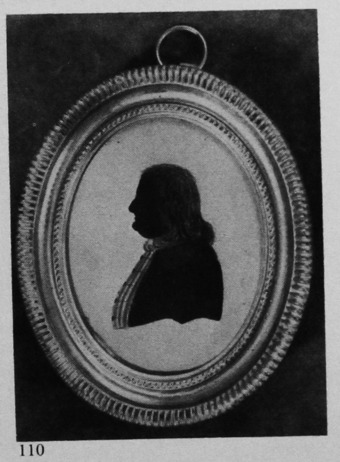
Unknown man, perhaps a servant or a labourer, of Windsor.
Silhouette by T. Wheeler, 1789. (See 177 for a silhouette by Wheeler of the sitter’s wife).
costume dating points
The loose, uncurled natural hair, such as was normally worn by servants or countrymen.
The single-breasted striped waistcoat, typical of the 1780s.
The cravat merely folded at the neck; a style adopted by the working classes.
The frock with a stand-fall collar, but without the fashionable lapel of the 1780s.
Author’s collection
Chapter 6
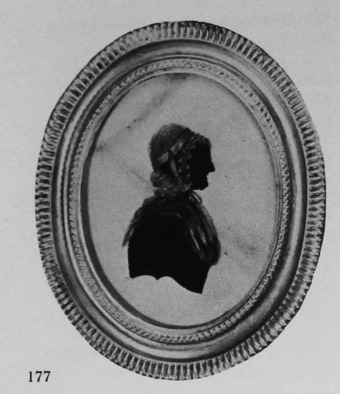
Unknown servant (or country-woman) of Windsor.
Silhouette by T. Wheeler, 1789. (See 110 for a silhouette by Wheeler of the sitter’s husband).
costume dating points
The absence of a fashionable hair-style.
The cap, of a type worn only by servants or country people.
The handkerchief is worn loosely about the neck, without any attempt to follow contemporary fashion.
Author’s collection
SECTION TWO

Lieutenant Dugdale
Silhouette painted on card
? c. 1784
4 x 3½in./102 x 90mm.
Trade Label No. 1 (fragment)
Frame: pearwood, with flat glass with verre églomisé border
M. A. H. Christie collection
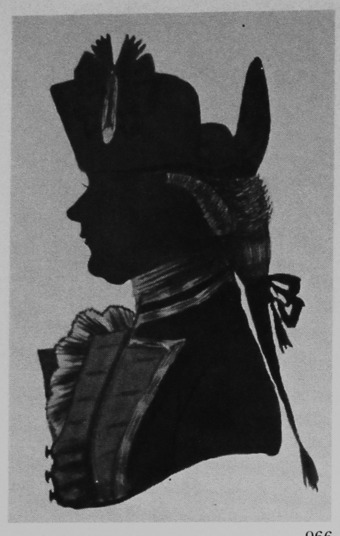
Unknown army officer
Silhouette pained on card
c. 1783-85
Although this silhouette has previously been attributed to William Wellings, comparison with the example shown in 965 leaves no doubt that the artist was Wheeler. It is the cockade on the fantail hat which suggests that the sitter is a soldier, and not a civilian wearing an à la marinière coat.
From the collection of the late J. C Woodiwiss
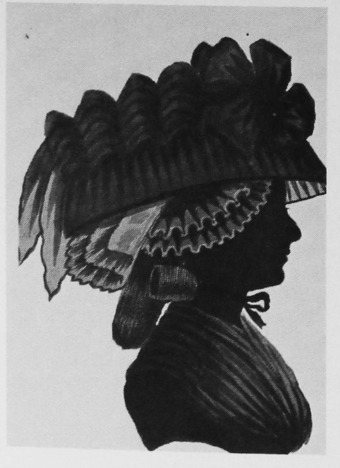
Unknown woman
Silhouette painted on card
c. 1784-85
A companion to the silhouette shown in 967, this example has similarly been ascribed to William Wellings, but must now, for the same reason, be regarded as Wheeler’s work.
From the collection of the late J. C Woodiwiss
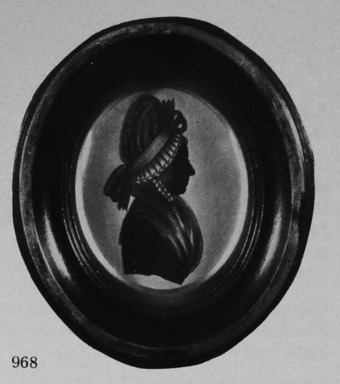
Mrs Mary Delany
Silhouette painted on card
c. 1786
3½ x 3in./90 x 77mm.
Frame: oval, pearwood
Previously described as the work of an unknown artist, this silhouette can now be definitely attributed to Wheeler.
By gracious permission of Her Majesty the Queen
969 ?
Fanny Burney
Silhouette painted on card
c. 1786-87
3¾ x 3¼in./96 x 83mm.
Frame: pearwood, with glass with verre églomisé border
This silhouette, previously attributed to A. Charles and considered to represent Queen Charlotte, must now be regarded as almost certainly Wheeler’s work, and the sitter is certainly Fanny Burney.
By gracious permission of Her Majesty the Queen
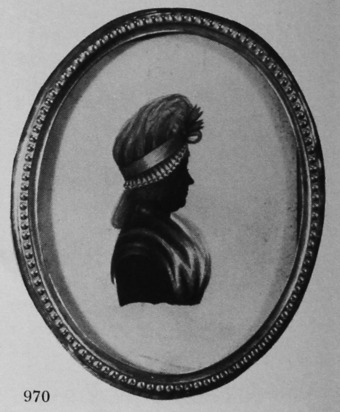
Unknown woman
Silhouette painted on card
c. 1786-87
4 x 3½in./102 x 90mm.
Frame: oval, hammered brass
Painted in the same style as the silhouette shown in 968, but in thinned brownish-black pigment.
Mr and Mrs J. H. Gutteridge collection
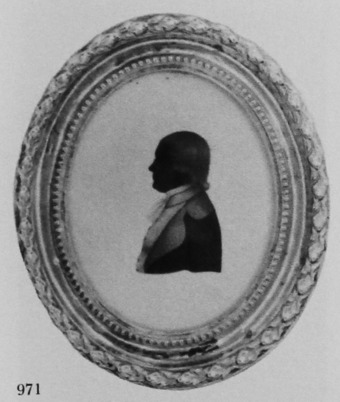
Unknown man
Silhouette painted on card
c. 1786-87
4 x 3½in./102 x 90mm.
Frame: oval, hammered brass
Companion to the silhouette shown in 970, this example is likewise painted in shades of thinned brownish-black pigment.
Mr and Mrs J. H. Gutteridge collection
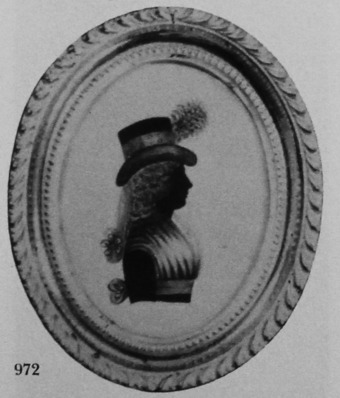
Unknown girl, possibly Princess Mary
Silhouette painted on card in brownish-black
c. 1790-92
3¾ x 3in./96 x 77mm.
Frame: oval, hammered brass
At this date Princess Mary was aged fourteen to sixteen.
Author’s collection
